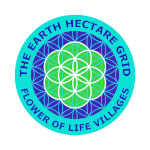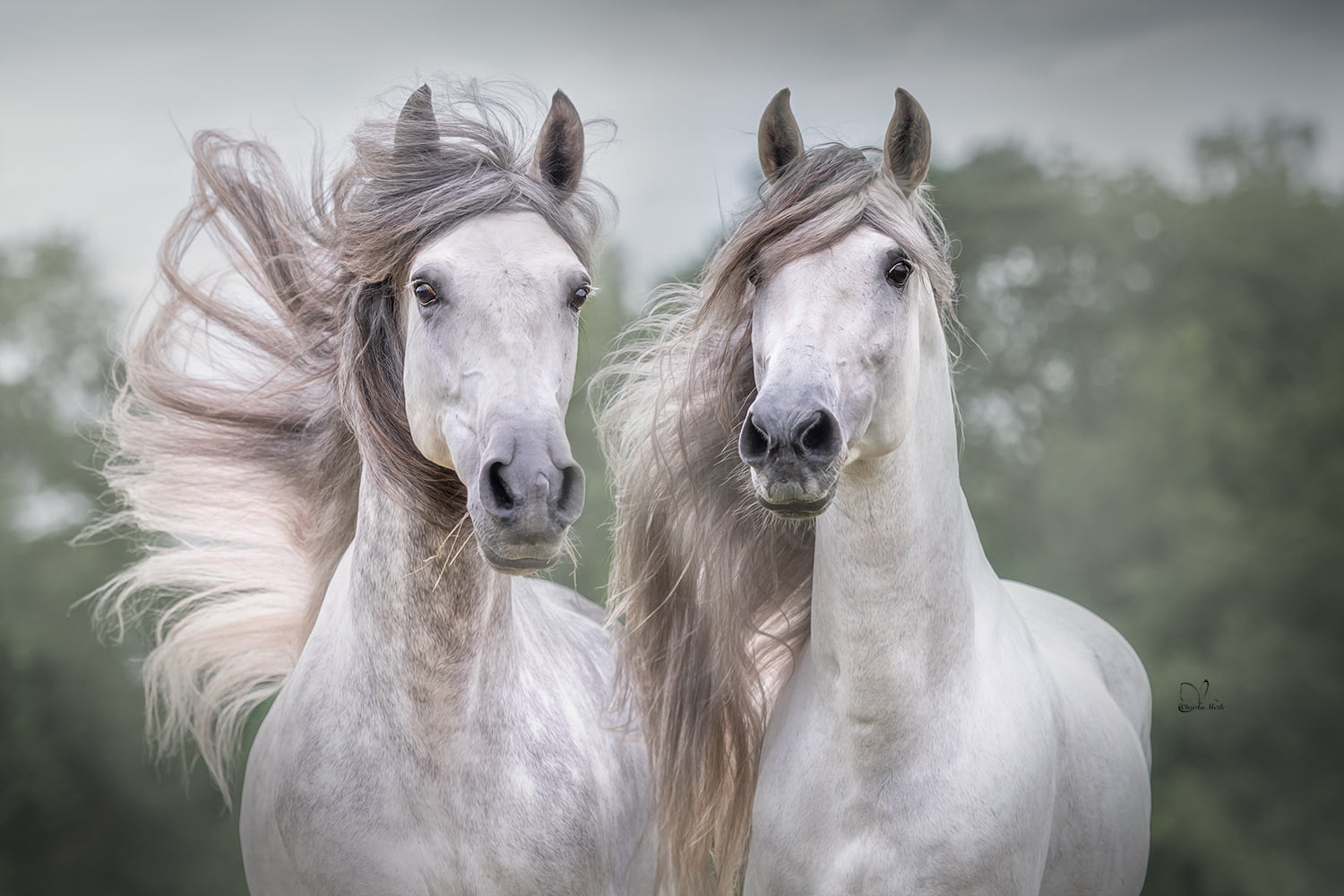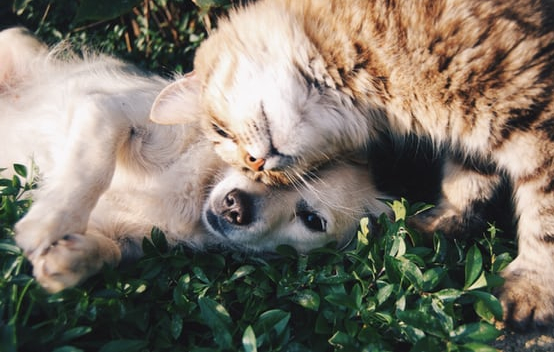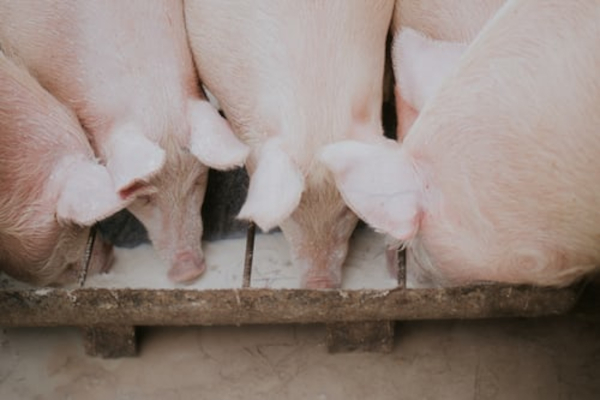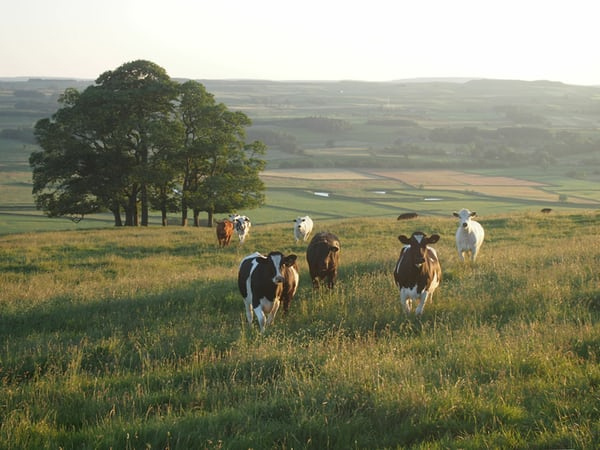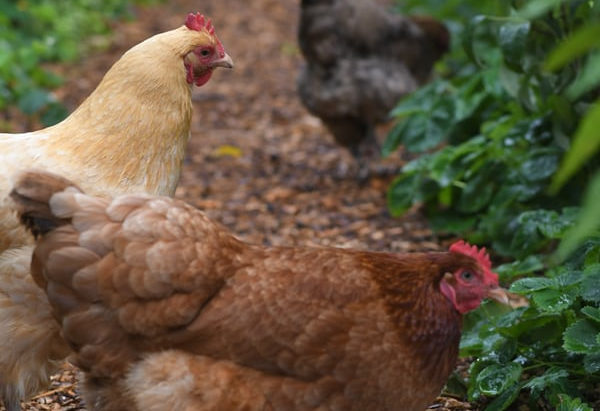22 FUNDAMENTAL RIGHTS
This page presents the fundamental rights of domesticated animals. In fact, they also apply to wild animals, because these rights are universal in nature.
When animals do not have a healthy habitat and territory of their own, unnecessary suffering ensues, and even their evolution is endangered. What to do about that?
There are 22 basic rights of domestic animals. For the origin of these rights, see ‘origin rights’. These basic animal rights could help improve the living conditions of animals worldwide.
7 CATEGORIES
The 22 fundamental rights are divided into 7 categories. Every category contains rights that apply to many animal species. With every category is also one particular animal species highlighted. Such as ‘Horses’. It is accompanied with a large picture of that animal species and an emblem that symbolizes the lawfullness of these rights.
It would be great if these animal rights could also be added to the constitutional laws of the hectare villages, and who knows, one day worldwide to all governments of the world!

22 FUNDAMENTAL RIGHTS OF DOMESTIC ANIMALS
“Animal rights are essential for the restoration of the intrinsic value of the animal, and for the expression of essential characteristics.”
-1-
PRIMARY LIVING CONDITIONS
-2-
SOCIAL-EMOTIONAL NEEDS
-3-
HEALTH PRESERVATION
-4-
NATURAL REPRODUCTION
-5-
IDENTITY AND DIGNITY
-6-
EVOLUTIONARY DEVELOPMENT
-7-
ANIMAL-WORTHY END OF LIFE

PRIMARY LIVING CONDITIONS
- 1 -This first category contains a list of all rights that belong to the primary living conditions of domestic animals.
Christa Merk Fotografie
Horses
Did you know that a horse is visually very strong? They are spectators, and indeed, where many species of animals have telepathic abilities, horses are even gifted visually telepathically. For example, a horse is able to create visual images and transfer them telepathically to its peers.
And when a horse is domesticated, it can do the same with its owner. Then the owner must have a strongly invigorating realm of images at his disposal so that he can pick it up. So that will take some practice for most of us. 😉
Horses also have a strong sense of smell and are a refined listener. People then think about language. For a horse, it goes much further than listening to language. A horse feels behind the words and feels it before there is language.
If you are someone who gets on a horse mindlessly, but you are full of confidence and you have a bond with the horse, because you have known the horse for a long time, then you never have to repeat what is obviously already established.
He has already understood, he knows your appearance, he knows your comfort zone in dealing with him. He knows where he stands with you. He knows you’re going to set your limits when he gets really headstrong. On average, language is completely superfluous in such a relationship. But then you are talking about an advanced relationship between horse and owner.
1 – PRIMARY LIVING CONDITIONS
1.1
“THE RIGHT TO HEALTHY WATER AND FOOD, THAT IS FOUND IN A NATURAL WAY.” ©MdV 7
This right means that animals should have the opportunity to find their own water and food, and to consume it in an animal’s own way.
Because animals need to express their own searching behavior that they naturally have, for fresh water and natural food sources. This deserves access to good quality (pure) water and food. It is therefore free of contaminants, and preferably contains regionally grown fodder.
Why this right is apparently not self-evident for people’s interaction with animals? See the explanation below.
EXPLANATION 1.1 Artificial Feeding
‘FAT- & PROTEIN RICH’
Animals kept for consumption often have to eat what is offered or forced upon them in order to grow as fast as they can. And this food is not always what they like. Or what they naturally love! For example, they are served food that makes them as fat as possible. Or protein-rich, so that milk production can continue to flow.
‘FEED NUMBERS’
On most farms breeding sows (mother pigs) are fed chunks twice a day. These they have eaten in about five to ten minutes. The feed does meet the (minimum) nutritional need, but is also responsible for a very limited feeling of satiety, so that the pigs can easily be fattened, because then they continue to eat (until they have become a kind of gigantic roll mops), and until the frequent occurrence of stereotyped behavior, and even forms of complete apathy.
‘CHICKENS’
In chickens, and especially in broilers, abuse is made of not being able to keep a measure when eating (due to a dysregulated hypothalamus). As a result, the crop becomes too full and the trachea is partially closed and the animal suffers from chronic oxygen deficiency. As a result, these feeding methods, for example cows, pigs and chickens, lack their own search behavior for naturally found food.
However, this also applies to pets. They receive food from a can or cardboard packaging. Sometimes animals are also afflicted with having to consume animal food when it is not in their nature to do so. This is usually incorporated in the feed. For example, bone meal between food for herbivores and grazers.
1.2
“THE RIGHT TO TAKING WATER AND FOOD YOURSELF IN A NATURAL WAY.” ©MdV11
Where the previous right is about seeking and finding water and food themselves, as animals would do if they live free in nature, this right is about taking in water and food themselves.
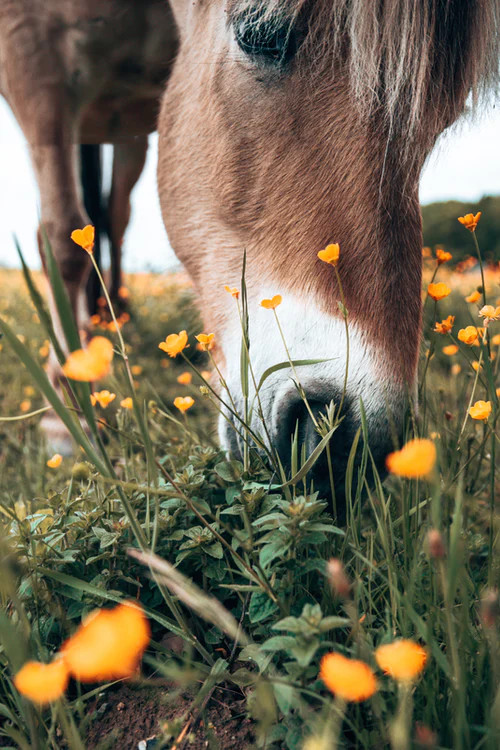
EXPLANATION 1.2 Fattening Feeding
FEEDING METHOD
A well-known example from the past, how not to do it, is how geese are fed through a funnel, to fatten them for goose pâté. Because the head is held up and a funnel is placed in the forcibly opened beak, the liquid food is poured into the throat via the funnel. As a result, the goose cannot help but swallow. Today, this method is banned in France. But the animals are still fattened, albeit to a lesser extent. So that goose pâté will still taste pretty good as a delicacy, that is, if you do not know how it’s produced. It goes without saying that fattening is completely against the animal’s nature.
1.3
“THE RIGHT TO SHELTER, IF THE ANIMAL NEEDS IT FOR ITS CONSTITUTION, TO SURVIVE FROM WINTER TIMES OR SEVERE WEATHER.” ©MdV9
The right to shelter in order to survive harsh weather influences such as rain, winter cold and summer radiation and heat. Today, and when feasible given the circumstances, ‘survival’ also includes evacuating animals from areas where habitat is threatened, such as floods and wildfires.
…
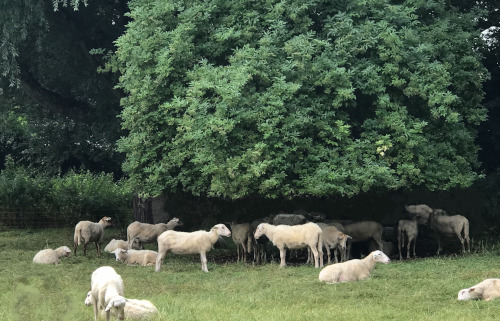
These freshly sheared sheep were sheltering from the rain. They seem to be comfortable, although there’s not enough room for all of them. And to think that many meadows in the Netherlands have no trees or sheds to shelter under. Then you often see cows standing with their butt against the wind, because they absolutely do not like whipping wind nor pouring rain!
EXPLANATION 1.3 (text will follow)
TEXT
will follow
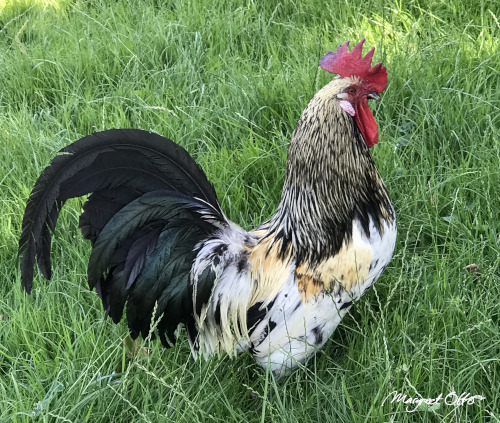
This proud rooster went for a nice pose. With in the background three hens in an apple orchard in his retinue.
1.4
“THE RIGHT TO AN APPROPRIATE AND COMFORTABLE SUBSTRATE IN SURFACE AND GROUND STRUCTURE, MATCHED TO IDENTITY, LIFESTYLE AND BODY CONSTRUCTION, SO THAT HOW AND FOOT STRUCTURES STAY HEALTHY.” ©MdV10
The right to a suitable surface to prevent degeneration symptoms, leg, hoof and claw problems.
LEG-HOWS AND CLAW PROBLEMS 1.4
LEG-HOWS AND CLAW PROBLEMS
What Marieke de Vrij sees above all, is that the hoof, as it stands on the ground in many production animals, suffers greatly from degeneration. For example, all animals that are on metal grids, that is not okay. This degeneration substantially affects the animal’s identity. (Remember, the entire weight of the animal rests on the hooves, and often there is no room in the stables for the animals to lie down. Moreover, there is also no grounding with the Earth, which is important for the natural electromagnetic energy flow).
Also, for example, chickens that stand on a concrete surface, or also on a grid, they miss that they can’t sharpen their nails enough on natural material. There isn’t enough pebbles nearby for them to walk on, resulting in their nails becoming rounded and also putting a stifling pressure on themselves in their standing. It doesn’t feel.
In the poultry sector, leg fractures and degeneration symptoms of the breed also arise, among other things, due to excessive fattening, especially in broilers. There are also leg defects in pig farming.
BREEDING SOWS
What is happening to the breeding sows is distressing. These have to stay in cubicles that are too tight and are forced to produce too high a piglet production (on average, ten piglets twice a year). For this reason, lameness is also observed in 8% of the animals, and claw lesions in 86% of the animals. In general, the risk of leg defects is further increased by slatted floors and slippery concrete floors.
1.5
“THE RIGHT TO A NATURAL LIFESTYLE IN CONNECTION WITH THE NATURAL DAY AND NIGHT RHYTHM AND THE COSMIC CYCLES OF SEASONS.” ©MdV 8
The right to a way of life in accordance with the cycles of nature.The right to a way of life in accordance with the cycles of nature.
ADDITIONAL INFO 1.5 Conditions Light
NORMAL DAYLIGHT
In many stables artificial light is on at night. Hundreds of millions of animals, including chickens, stay in pens and stables day and night. Normal daylight is not or minimally present in it. And as a result, the animals must always, or for the most part, stay with artificial light.
The light intensity required by law is also very low in pig farming, and 12 lux in the stables at animal height. It is therefore important to bring natural daylight back into animal housing.
Barn animals, for example, thrive much better in sheds with windows. They can slowly get used to the change of day with night through the twilight phase. And a laying hen likes to lay her egg in a quiet dark place
TWILIGHT PHASE
Experiencing the twilight phase is also very important for animals. In stables and battery cages, the light is switched on and off in one go, so that there is no natural transition with a twilight phase. That is very important for animals, a twilight phase, because they have a very specific animal behavior of their own.
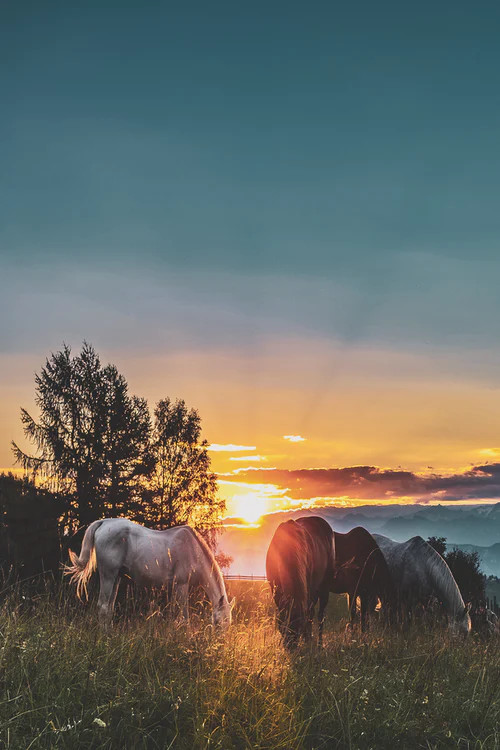
LIVING OUTSIDE
In intensive livestock farming we sometimes also see that, for example, cows are kept indoors for a long time, sometimes even permanently, despite acceptable weather conditions outside, in which it would be possible to spend some time, or a long time, outside during the day.
And did you know that cows really revive when they can look at the starry sky at night? Or when the moon shines, they dream away completely. As long as the temperatures remain above zero and there is not too much wind or it rains for a long time (if there is no shelter outside), they will be very happy with that.
It would increase their resilience and strengthen their constitution if the animals were regularly aired in winter conditions.
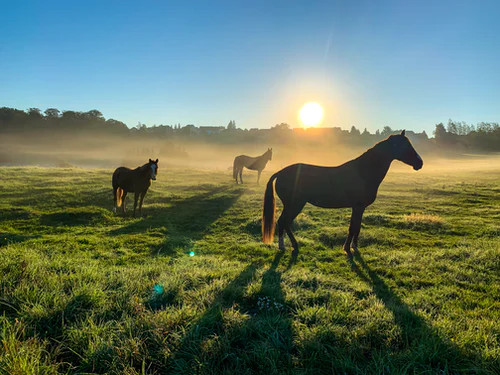
The importance of going through twilight, both at dawn and dusk, is very important for experiencing the day and night cycles, and also links the animals to the cosmic cycles of the seasons.

SOCIAL-EMOTIONAL NEEDS
- 2 -This second category lists all the rights that belong to the socio-emotional needs of domestic animals.
Pets
Firstly, the recommendation that if you keep pets, but in fact it also applies to horses or a goat or a donkey, if you are going to care for an animal, get more of one of a kind together. So preferably two cats instead of one cat. Two dogs of the same kind instead of one dog only, etcetera, so that they have an equal with them!
Then it is important to give them space for what they need in their movement rhythm, in order to meet this to a considerable extent. In particular, animals, from which a strong adaptive behavior is expected, are often too tired of the adaptations they have to make to be considered decent for humans. This means that loneliness takes place on a deeper level. Animals mainly need an ‘extended’ existence.
‘Extended’ here means: living space. So give your animal the necessary walking space, so that they can meet their need for exercise. This is especially true for rabbits and guinea pigs, which can have huge territory in the wild. Usually, in our civilized world, these animals spend their entire lives in a cage that is far too small, and they perish from boredom and monotony.
Cats and pussycats (in general cats), really make ideal pets! (If you like them eh). It is interesting in itself to look at these idiosyncratic beings from a spiritual side. When Marieke de Vrij attunes herself to the cat, she can feel it and also see images. She states that cats sense when there is an imbalance somewhere, and also when there are healing energies.
When cats purr, they have a certain vibration in their body with which they radiate beneficent energies and thereby neutralize displeasure in the person they are sitting on.
Then you also have cuddly cats that sometimes put their front legs on your shoulders, their hind legs are on your thighs, they stretch and flatter their entire body over all your chakras with that movement. And thus they express reassurance! So touching! Presumably, if they do this, they feel that your chakras are not properly balanced and will lie in front of them so that they function more evenly.
The next picture is that cats like to sleep by the feet or the abdomen of people. The nice thing is that they do that to themselves too. They thereby strengthen their own energy field. Indirectly they also rebalance the person with whom they are lying, because they are in the pelvic region, they introduce more of the fundamental tones in the frequency of our auric system. Because they generate those fundamental tones more deeply in us, we breathe in more deeply and because we breathe in more deeply, it strengthens their electric field. That way we are both happy!
Cats also have a certain sense of decency. So if they have killed a mouse, they actually want to offer it so that we can clean it up. They can also see a mouse as a toy, but are less concerned with the mouse’s suffering. Perhaps this is after all for the cat practicing the skill of chasing? Because although it is usually fed by humans, the hunting instinct remains in the cat as a survival instinct.
2 – SOCIAL-EMOTIONAL NEEDS
2.1
“THE JUSTIFIED KNOWING ITSELF PRESENT ON EARTH, AND KNOWING ITSELF WELL WITH THAT.” ©MdV 1
In other words, the animals can be consciously living on Earth, and also be well according to their natural being! But unfortunately the right of said social-emotional needs in domestic animals is not always self-evident. And that also increasingly applies to the wild animals. And all because of man!
Passing on the Fundamental Rights of Domestic Animals is therefore essential. Because these are there to restore the intrinsic value of the animal and thus make its position and task here on earth worthy of an animal again!
2 – SOCIAL-EMOTIONAL NEEDS
2.2
“THE RIGHT TO EXPLORE ONES OWN RIGHTS AMONG PEERS ACCORDING THEIR SPECIES-SPECIFIC STANDARDS.” ©MdV3
This right concerns, among other things, the naturally occurring group size, mutual recognition and their natural rank and order in a herd.
It is also important to let older animals live because they serve as an example for the young animals. Without the role of older animals, the herds lose their collective memory and identity.
LEADERSHIP & MATING DANCES 2.2
And tightly packed in stables or battery cages, for example, animals have no possibility of ritual movements. Such as the rituals between male animals to confirm leadership.
Another example is mating dances, in which the animals choose their own partner. This is a mate selection according to the laws of nature.
Due to human interference however, male and female ‘consumption’ animals are only brought into contact with each other at production level. Such as artificial insemination in cows.
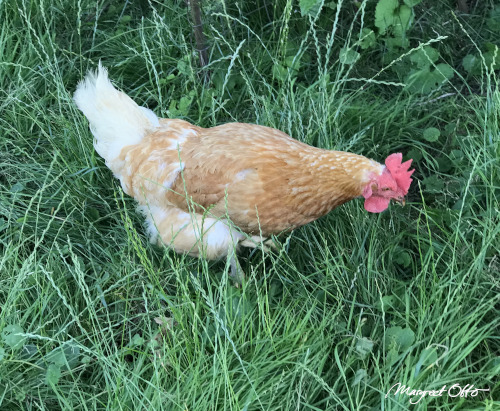
This happy hen  (one of the three ladies belonging to the rooster pictured earlier), rummages fine in the soft grass, and picks up some worms here and there. A gravel path, sand or pebbles also belong to an ideal soil for chickens.
(one of the three ladies belonging to the rooster pictured earlier), rummages fine in the soft grass, and picks up some worms here and there. A gravel path, sand or pebbles also belong to an ideal soil for chickens.
2.3
“THE RIGHT TO BE INCLUDED AND TO FEEL GOOD WITHIN ITS OWN COMMUNITY” ©MdV4
All animals have the right to live with conspecifics in their own community, but also together with other animal species. Within a company, for example, several animal species can safely thrive together, and it even promotes well-being. However, it is important to always keep two or more of each species. Animals are also social beings, and need each others company to thrive.
Animal lovers usually only take one animal, such as one horse or pony, one cat, or one dog, or one rabbit in a pen. If a cat, or dog walks in the open field or on the street, it will certainly meet peers and therefore also recognition.
But that one single horse, or that one donkey that never meets one of its kind, can only identify with people.
And that may benefit the love of animals on the part of humans, because the bond becomes closer and closer, but what does it do to an animal’s identity if it never meets a congener?
2.4
“THE RIGHT TO SUCH A LIVING SITUATION THAT THE TELEPATIC CONTACT AMONG ANIMALS ISN’T OVERRULED OR DISTURBED.” ©MdV 5
For example, when an animal is in an environment in which there are overruling sounds of all kinds, the animal can’t maintain sufficient telepathic contact with its congeners, or even have no telepathic contact at all.
TELEPHATIC CONTACT & DEHORNING 2.4
TELEPATHIC CONTACT
How can an animal ground itself in accordance with its own being, and shape its own identity in an animal-essential way? Then, to begin with, there should be no blocking influences that stand in the way of the telepathic contact of animals.
CREATING IMAGES
But did you already know how animals experience telepathic contact? Telepathic contact takes place, among other things, because animals create images in their minds. These are taken up by peers.
For example images of food, of water, of mating behaviour, and so on. However, if a lot of chaotic sounds are active in the environment, the animal becomes emotionally numb. It turns in on itself. It becomes exhausted inwardly.
As a result, it can no longer understand itself inwardly. The animal can no longer do that within its essential characteristics. It can no longer feel open to other animals.
For example, if you have tens of thousands of chickens in a battery cage in one place, piled up in cages, in a deafening squabble, which mainly arises out of emergency, then there is no longer any healthy communication between them.
WHOLE HORNS
The dehorning of animals, such as cows and goats, also causes a disturbance of the telepathic abilities, and thus the living situation. Horns for an animal are, as it were, ’telepathic radar systems’.
When you dehorn an animal you also break part of its telepathic cosmic contact. So it is not optional for an animal to be dehorned. Dehorning also makes the animals unwilling. As a result, they are less focused on essential nightlife.
DEEPER WILL
Then we are talking about a deeper will. People have a will of their own, and a will corresponding to an essential task. But embedded in their evolution there is also an essential mission in the animal. An example of this is that they are in contact with their peers. And also with all the elements around them. But by dehorning it is as if something in that will, in order to be in a good connection with it, is interrupted, in the sensitive feeling of others and their environment.
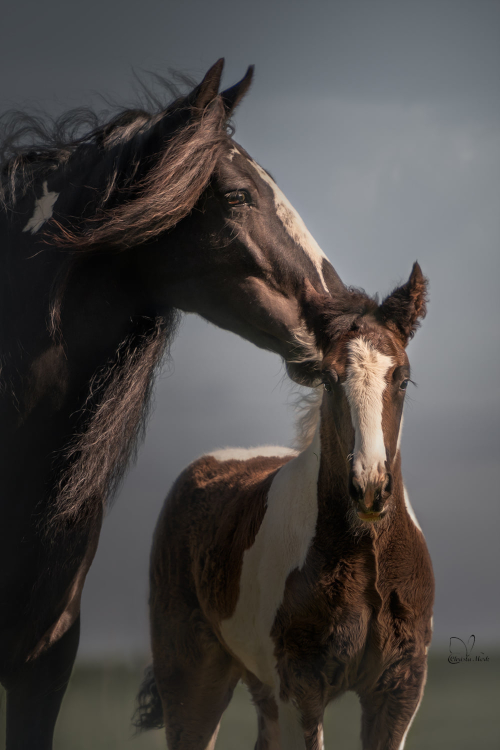
2.5
“THE RIGHT TO CHERISH HIS OR HER OWN OFFSPRING, TO LOVE IT AND TAKE CARE FOR IT IN A PHYSICAL WAY, THROUGH WHICH THE ANIMAL THAT IS BORN CAN ACKNOWLEDGE ITS RIGHT TO EXIST, AND DEVELOP SPECIES IDENTITY FOR AS LONG AS THE YOUNG ANIMAL NEEDS.” ©MdV16
BALANCED LIVING
If the animal is to live on in a healthy, balanced way, and in order to produce good offspring in accordance with its nature and identity, it is essential that it can be cherished and loved by its parents or mother after birth. Hundreds of millions of animals just in the Netherlands alone are denied this because of the human urge to produce.
From the point of view of the animal’s interest, it is important that young animals stay with their mother or both parents, and in the community of their congeners for a reasonable period of time.
If an animal never developed a family sense and a group sense, it always walks around with a kind of homesickness. Such animals haven’t learned to connect with their peers. That is also the case with humans.
THE RIGHT TO EXIST 2.5 - 1
So not only people, but also animals have the right to cherish and love their own young, their own offspring, in a physically grounded way. As a result, the animal that is born can recognize its right to exist. That applies to all animal species! Logical, you would think. But does that always happen?
For example, what about a chick that is hatched in an incubator? He suffers from loss of identity from the start. Moreover, consumer animals often do not live more than one seventh (some say one sixth) of the age they can live.
So we intervene in the animal races to such an extent that they do not know what old age is, not what middle age is, and few animals even experience their youth. As a result, there is insufficient empathy at the level of all age categories that are feasible for the animal.
In addition, enhanced degeneration and the long-lasting effects of inbreeding cannot be sufficiently perceived by people (and consumers). For example, have you ever thought about why only cows are grazing in the Dutch pastures? And then cows as being the ‘ladies’. But where are the ‘lords’, or the bulls?
Well, most male calves are usually taken from their mothers within one day of birth, or two to three weeks after that. These calves are fattened in intensive livestock farming (thus not with their mother’s milk), and slaughtered for veal after an average of 3 months. If this practice did not exist, the calves could have grown into adult bulls, which can live to be about 17 to 18 years old.
Huh?
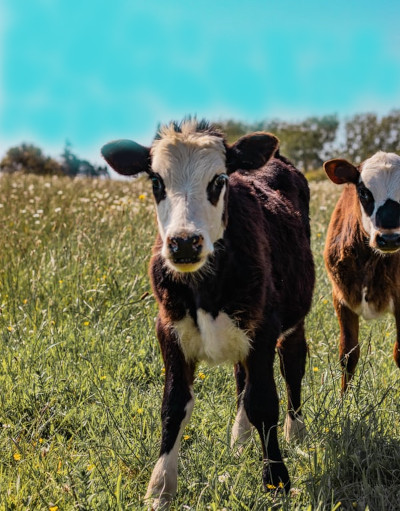
So, in a sense, there is a collective death of male animals in the Netherlands with regard to consumption animals (also with regard to the baby chicks of chickens, in particular all roosters, and almost all male baby goats).
And what other implications does it have for the calves of cows? During their short lifespan they therefore often do not receive breast milk but alternative food, and as a result suffer from anemia. Very simple, a baby needs milk. The anemia makes the calf feel very sluggish and weak. Moreover, by early removal from the mother cow, the calves cannot build their identity either.
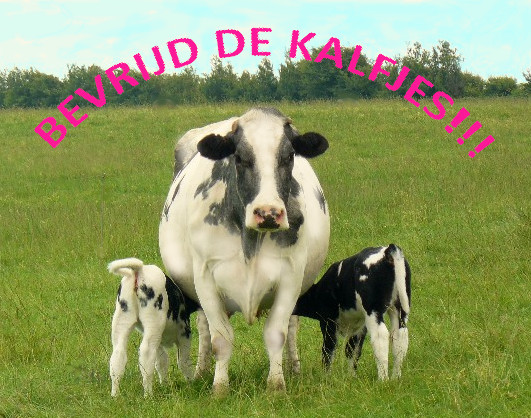
The removal of the calves therefore results in a horrible state of being, both for the calves and the cow. But their meat and dairy tastes good to the people! However, we prefer to see it as in the picture above. Does this mean that people should no longer drink milk at all? No, not that. A cow is willing to give a little more milk to humans during the period that the calves are suckled. After that, however, the mother cow deserves some rest, and the calves can lead their own lives, including the bulls! So, for example, we could save our limited dairy products for the last phase of winter, when fresh local produce is no longer available and we can use some extra energy. After all, dairy is a powerful food!

There are also alternatives for the summer months. Coffee with soy or oat ‘milk’ is also delicious! For example, in many catering establishments you can already ask for this and it is served like this!
Reduced dairy consumption by us noble people, of course, also has implications for intensive livestock farming. A solution to this could be that farmers’ incomes remain the same despite reduced production of their cows.
And that all investments in intensive livestock farming that have already been made will be compensated by the government. And that there will also be compensation for farmers who want to keep their animals organically.
That should be rewarded on all fronts! After all, we can all thrive. And wrong political policy, must be corrected.
It is also important to consider the consequences for the mother cow. See Explanation 2.4 Continuation 2
IMPACT GENOCIDE MALE ANIMALS 2.5 - 2
Nipple infections often develop in the mother cow after the calves are removed. According to Marieke de Vrij, the cow mourns the removal of her calf and remains telepathically connected to the calf for months. The cow also experiences that her calves are being fattened and how they feel very uncomfortable (iron deficiency, brittle bones, no parent to take care of them).
The mother cow is telepathically informed about her calf all the while and it’s no wonder she suffers from nipple inflammation. And the farmer is not allowed to use penicillin to ward off those nipple infections, because that cannot be found in the milk.
It is best for a cow to keep the calf with him until the calf enters the stubborn period. That is approximately between five and eight months. If you then separate the calf from the cow by putting it in an adjacent meadow, they still have contact with each other, without being really together. That’s going well.
And the next phase is when you take them apart for good. That causes the least suffering. Keeping them together for four days is very little, because the first attachment has already taken place, but it is different if the calf leaves during the stubborn period.
Fortunately, this is already happening in biodynamic livestock farming in our country. There the calves really stay with the mother cow for months. And many ‘regular’ farmers also want to switch to this concept, or are already doing so. But better would be to have the cows live their entire life, right?
PIGS
Also the pig’s piglets are unfortunately removed too young. They are ‘weaned’ as it is called after 3 to 4 weeks, so they are removed from the mother sow, which would be up to 10 weeks in a natural process.And because the piglets have to switch to solid feed at much too young age, this also leads to major disruption of their gastrointestinal tract.
The piglets suffer from ‘weaning diarrhoea’, among other things. These symptoms are combated by means of antibiotics, growth promoters and zinc and copper products. This in turn has implications for public health.
THE BREEDING SOW
But we are not there yet. Because another example is the breeding sow. Due to the way in which these mother pigs are treated, the animals are ‘burnt out’ within 2 to 2-1/2 years. But then they are simply replaced by ‘fresh’ breeding sows. However, the estimated lifespan for pigs is about 12 to 15 years under natural conditions. It is known that fewer piglets are crushed to death in sows raised in a family context. And we are still not at the end of this speech.
THE CHICKEN SHREDDER
A chicken can normally live to be about 7 years old. But here too many male chicks, or the roosters, disappear immediately after they have hatched by the (wood) chipper, also known as a chipper. These are several razor-sharp knives that make mincemeat of young life in a very short time.
And that says something about the subconscious mind in the Netherlands, that it takes place here. All of this is happening collectively with different animal species. This concerns hundreds of thousands of animals on a yearly basis.
We can ask ourselves: What is active in people that allows this to exist? Because we are apparently a civilized country. How is it possible that animal rights are being violated so massively in a country like the Netherlands?
2.6
“THE RIGHT TO PROCEED SPECIES-SPECIFIC FOR THE LOSS OF OFFSPRING, LIKE WITH MISBIRTH, DEATH, REMOVAL, AND WITH ANY OTHER FORM OF MOURNING, SUCH AS THE LOSS OF A PARTNER AND CONGENERS.” ©MdV17
The right to species-specific mourning in the event of loss or removal of offspring, partner and congeners.
THE RIGHT TO MOURN 2.6
It is rarely considered that animals can also mourn. That is why we roughly separate the calves from the cows, almost immediately after their birth. The only grieving process a mother cow gets is calling for her calf for days and in vain in the meadow.
Incidentally, it has often been observed and thus known that specific mourning expressions exist within different animal species.
TAKE AWAY NEWBORN?
At present, therefore, newborn animals and young animals are being removed from their parents on a large scale and in a gross manner. And this also happens without room for mourning for the animals left behind. This has significant consequences for the health and identity of the species for both the young and the parents.
The family and group ties are improperly and unnaturally broken, as with pigs, which naturally live in family groups. In addition, there is collective mourning about premature loss of life.
The question we humans might ask ourselves is how ethical it is to take newborns away from their mothers, while also slaughtering most of the newborn males? (regardless of which animal species).
2.7
“THE RIGHT TO TAKE DELIGHT IN PLEASURE TO PLAY.” ©MdV 6

EXPLANATION
Explanation of 2.7
The right to enjoyment of play includes the experience of self-pleasure in relation to oneself and peers, among other things through the experience of sensory stimulation and the acquisition of fine sensory perceptions.
In this it is about stimulating the senses from a pleasant experience, so that the animal experiences self-pleasure in relation to itself and others.
STARRY SKY
Besides playing with each other there are also other pleasures. For example, pigs love mud baths, cows can enjoy watching the moon and starry sky at night, and chickens love dust baths.

HEALTH PRESERVATION
- 3 -This third category contains a list of all rights that belong to the maintenance of health of domestic animals.
Pigs
Did you know that the pig is very sensitive by nature? They like to come into contact with other animals. They are playful by nature, and like to know themselves! They can also feel very elated within the elements of nature, and self-protection is foreign to them.
That is unless they are forced to do so by human actions unworthy of animal cruelty. Because a pig is an animal that does not naturally function in defense. Before an animal like this reacts from defense, there is a lot going on. For it is not a type of ruff, but a very gentle animal. He just loves the natural elements and can behave very comfortably in them..
CAN IT BE BETTER?
Unfortunately, the conditions within intensive livestock farming are not always ideal, and sometimes even distressing. In the Netherlands, for example, no fewer than 40 million pigs are slaughtered every year as consumption animals. (and that on a population of 17.4 million people, so that’s a little more than 4 pigs per person, including babies, children and vegetarians).
When Marieke de Vrij connects herself with her sensitivity to the ‘collective field’ of Pigs, she feels that the animals individually become very lonely. This is because the pigs are too tightly clustered within a certain type of barn. As a result, in spite of their senses, they have become aggressive towards their fellow animals. They do this out of preserving their self-identity, but at the same time it feels to them as if they have lost it again. (Awful!)..
The animals are not accustomed to living tightly together, have gone to great lengths to keep themselves among others, and have become taxed, and suffer from immediate exhaustion. It also feels like sows are experiencing accelerated miscarriages during this period as if they just can’t hold it. It’s as if there is such despair.
CAN PIGS ESCAPE?
Well, unfortunately they cannot, and because of all this there is a great dejection among the animals. They also feel a lot more sluggish than they normally feel, and that’s right because they are specially fattened. The ‘flirty’ inherent in the pig has therefore been taken away from the pig, as it were. There is also a great sadness going on with them about the intuitive feeling that large numbers of pigs of their own kind have been removed.
Those left behind ‘moan’ as it were inside, in a kind of realization that all kinds of things are happening. Due to the tight confinement, the chest is pushed forward, as it were, more proportionately, in opposition to the self wanting to continue to survive. As a result, the pig’s body does not have a nice collapsed feeling, but is overstretched.
FROM A SPIRITUAL PERSPECTIVE
As long as humans take away a dignified life from pigs (see also the explanations), there will be more and more ‘incarnation problems’ in pigs. Because they just don’t like to come back. There is even fear of being born again, given how often things are. This is especially true for pigs at pig fattening farms. Fortunately, there are also many farmers in the Netherlands where the pigs are still having a great time, and even better, there are more and more!
SOME MORE FACTS
Pigs are ‘enthusiastic about the environment’, just like humans. They greatly overlook the possibilities that are available to them, so that it is sometimes even possible for the pig to run further and forget to stop in time, as man does on a spiritual level.
Pigs are also intelligent creatures, who do not pride themselves on this, but patiently practice their intelligence, sometimes to the despair of their peers. There, once they have discovered something, they take pride in it, and practice it over and over until it almost makes them mad themselves. The type of meat of pigs has similarities with that of humans.
Pigs also have a more intricate tissue due to their special sensitivity of structure and the fine sensory perception fields that go with it. As a result, the fineness of their tissue structure resembles human tissue. (for this reason, this is sometimes also used for medical applications in humans, see explanation).
3 – PRESERVATION HEALTH
3.1
“THE RIGHT TO HEALTH PROMOTING CONDITIONS, FROM HUMAN TO ANIMALS.” ©MdV13
For example, through human action, accommodation areas can be improved, such as stables or sheds on a meadow. Also consider furnishing the living areas with natural daylight, which is also draught-free, and which is also resistant to wind and rain.
TOELICHTING 3.1 Cramped Pens & Stables
TOO SMALL STABLES
Pig piglets are often born to mother pigs (breeding sows) that are kept in cramped pens. These are surrounded by latticework. The question is, first of all, whether we are allowed to treat mother animals in this way, because they have no quality of life if they are denied any form of natural life (except the pregnancy of baby sows & giving birth). Btw, it is known that no piglets are crushed to death in sows that have been raised in a family and are allowed to stay outside or in large barns.
VENTILATION AND TEMPERATURE
In pig stables you often see complicated ventilation systems and temperature control. This is partly because of the ammonia emissions that affect the pigs’ alveoli, causing the lungs to become inflamed and the pigs being given antibiotics. This medical intervention is necessary because of the circumstances to which the pigs are exposed, and is therefore culpable, but also a good revenue model for the pharmaceutical industry.
ANTIBIOTICS
The long-term use of antibiotics also has many snags, which means that in the long term, germs can actually penetrate deeper into the tissues. It promotes damage to organs in a certain way, ultimately undermining the physical and emotional resistance sensitivity. You can read more about this topic on the animal perspective website.
POOR CONDITIONS
In practice you see that many cows have to stand on concrete and in stables where they can hardly lie in, at most stand in, and that’s it. There is no view and they are milked by a milking robot. At mega stables, this even happens on a large revolving carousel made of metal, the so-called ‘moving floors’, no expense has been spared to automate everything. But… we are dealing with living beings. Cows are not things!
LARGE SCALE?
Cows, for example, like to spend time together, and forty to sixty cows together is still doable for them. They then know each other and they still form a kind of family group. But in those large cowsheds of today, that feeling is lost and they become more loners. Maybe nice for the farmers’ money, and especially for the stimulating government (tax), but it is no longer pleasant for the cows.
TOELICHTING 3.1 Physical Procedures
PHYSICAL OPERATIONS
In pigs, the tail is often amputated, and thus kept short-stubbed. The nerve endings in the tail are not as sensitive. But the tail is a territory matter for a pig. It is also sometimes the case that naturally living pigs consciously soil their tails or pass them through manure. So here too the animal is affected in its territory. Plus it’s a violation of bodily integrity.
TERRIFYING METHOD
Unfortunately, it doesn’t stop there. National regulations also leave a lot to be desired. For example, pigs are required to be tested for bladder disease using a terrifying method. This is called ‘drawing blood’. Blood is drawn in this way from 250,000 pigs in the Netherlands every four months.
Twelve pigs have to be pricked per farm. The size of the company does not matter, only the very small companies are allowed to prick fewer pigs. A live pig gets an iron noose around its upper jaw. The noose is then tightened and he comes to hang on it. This stretches the neck completely, making it easy to reach the vein. A long needle is then inserted into the vein to draw blood. Such a pig then screams like hell. The whole pigpen is then restless because of that death cry. Sometimes they also die on the spot from the stress.
And even long after that, they remember that that happened (when the same human who performs this act comes back into the stable after four months, all the pigs flinch against the wall or farthest corner). And to know that these diseases could be prevented if pigs lived in natural conditions. Therefore, this too is an offense against the animal kingdom.
STERILIZE AND NEUTER
With pets, you sometimes see cats being spayed before they’ve ever had a litter of kittens. In horses, stallions are often castrated, after which they are called ‘geldings’. However, a gelding behaves differently in a herd than a stallion and can be confusing to both the gelding and surrounding horses if no stallion is present to keep the collective memory of ‘men’ alive, such as leadership role and related matters, such as natural selection.
CASTRATION
Male pigs are usually slaughtered when they are five months old. Although they have not yet reached sexual maturity, they are still castrated without anesthetic.
This has to do with the fact that the pork of a sexually mature piglet can smell and taste very bad. For this reason, the piglets are castrated as a ‘precautionary’ or just to be safe. They are then transported alive to Italy and processed into Parma ham. These are several offenses by man against the animal, killing young life and castrating without anesthesia, while that is not even necessary.
EARTAGS
What you also see a lot in large-scale production cattle is the ear tags. These are yellow plastic tags with a number on them. They are registered in a computer system, so that the origin of the cow (and bull) is known. And so the economic value and the revenue model are also linked to this.
However, piercing the ear, often both ears, to attach a plastic tag is an invasive procedure. The animal never asked for that. Moreover, it is visually and ethically not acceptable. They come across as inferior by degrading the facial expression, like a face with a clown nose, so to speak. Also take in consideration, the cows and bulls are not born with a chipped plastic card and number on their ear. This is complete arrogance and pride of man, and must stop.
HOW?
Let’s put it this way, in a Hectares Village all the above actions are FORBIDDEN.
George Orwell’s saying ‘Some animals are more equal than other animals’ does not apply to the animals in a Hectares Village.
In a Hectares Village, the animals grow old in a normal way, are allowed to reproduce in a natural way, and are given sufficient territory where they can find their own food, or are additionally fed with species-specific food. If you can’t imagine all this yet, the complete picture looks a bit like the animals on the farm in the Miffy children’s books. In other words, they’re ‘Happy Animals’.
XENO-TRANSPLANT
The physical interventions also include the removal of organs or organ particles from pigs (and other animal species) for medical use in humans, such as the transplantation of nerve wires and heart valves. Whether these organs are taken from living animals or not, experiments are carried out with thousands of laboratory animals, for which an animal is not willing to sacrifice and does not want to cooperate, but is forced to do so.
THYROID POWDER
The thyroid glands of some pigs are removed immediately after slaughter and dried to powder for the extraction of thyroid hormones for people who no longer have thyroid function.
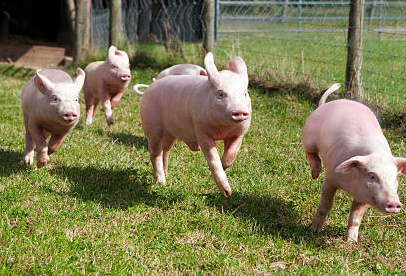
FREE THE PIGS!
If pigs could escape from their barred cages and dark stables, they certainly would! Perhaps the heroic deed is for us humans to help the pigs escape. Nowadays more and more farmers in the Netherlands chose to let their lifestock roam outdoors and give them organic feed. They do this against all odds of extreme commercial farming. They’re seeking a balance in producing good quality animal products, while at the same time raising happy animals. It’s possible.
3.2
“THE RIGHT TO FINALLY KNOW ONESELF STRONGER THROUGH ILLNESS, OR DIE, AND THEREFORE ENABLE A NATURAL DEVELOPMENT OF THE BREED.” ©MdV14
This implies helping to build up natural antibodies, so that an animal may become ill and also get better for a healthy breed development. Natural food supplements such as specific herbs can also aid in recovery.
EXPLANATION
Explanation of 3.2
DIVERSITY IN REPRODUCTIVE GENES
Natural breed development also includes natural selection of mates. But the aim in all sectors of intensive livestock farming, is to develop the ‘most productive animal’ in terms of meat, dairy or egg production through unilateral selection, by means of crossing and genetic manipulation of breeds. However, this adversely affects the diversity in the reproductive genes. In the long term, this even leads to many weakening of the various animal species. It’s a dead end.
ONE-SIDED SELECTION
The poultry sector has made the most progress in this respect. The ‘broiler chicken’ is a macabre example of this. In livestock farming, the ‘double-billed’ cow is another example of breed manipulation.
Due to abnormal muscle and tissue formation, this double-billed cow can no longer give birth normally, and all calves have to be born by Caesarean section. Unbelievable right? All of these practices dramatically reduce reproductive gene diversity.
DISEASE PROGRESS
Another example with regard to ’the right to ultimately know oneself better through illness’ is that the course of the illness develops differently without human intervention. Where thousands of animals have been slaughtered unnecessarily in order to prevent further outbreaks, it appears that on average the mortality risk in a foot-and-mouth disease outbreak is only 5% of the infected animals. In addition, if they would have been allowed to live, the remaining animals would have become more resistant. But it goes even further. (Click on the arrow to the right of the toggle bar below).
ARTIFICIAL INSEMINATION 3.2
ARTIFICIAL INSEMINATION
Since most bull calves are slaughtered within a few months, there are hardly any mature bulls in the Netherlands. A few years ago there were a total of 25 breeding bulls. So that’s already a pretty imposed incestuous thing. But unfortunately it goes even further than that.
Some ’top cows’ in the US are processed with hormones in such a way as to produce 10-15 eggs during a single ovulation. These are then removed and artificially fertilized, transported to the Netherlands in the womb of a live rabbit (OMG!), to ‘produce’ calves here through surrogacy of cows. These cows are also prepared for this via hormonal administration.
REPRODUCTION REQUIREMENTS FOR BREEDING SOWS
As a result of the housing and the high reproduction requirements, a chronic stress arises in breeding sows that has a negative effect on the fertility and the oestrus of the breeding sows.
As a result, it is the rule in pig farming that breeding sows are injected with hormone preparations to start oestrus again and to become pregnant prematurely, which in mammals leads, among other things, to slackening of the abdominal tissue.
It is seen however as an additional ‘production advantage’ that by administering these preparations and artificial insemination, animals can be synchronously fertilized in ‘production groups’, so that pig farming is made as effective as possible.
Question: Do we humans actually have the right to intervene in the evolution of the animal kingdom in this way?
3.3
“THE RIGHT TO EXPERIENCE ONESELF AS WORTHY WITHIN TRANSPORT CONDITIONS.” ©MdV18
The right to animal-worthy transport conditions such as during livestock transport, but also transport by private individuals.
EXPLANATION
Explanation of 3.3
TRANSPORT CONDITIONS
There is also a lot to improve on, as everyone knows by now. The transport of young piglets to Italy, for example, is often downright terrible. The animals are packed tightly together in trucks for days, deprived of water and food. And after they have been fattened here and castrated without anaesthesia, they are processed into Parma ham in Italy, before being returned to the Netherlands.
Can that be done differently?
BROILER SYSTEM 3.3
FOR INSTANCE
In the broiler sector, a specific container system is used for catching, loading and transporting broilers. This system prevents a large number of animals from dying due to stress or being delivered to the slaughterhouse maimed during the transport or capture of the animals. (effective result 50% fewer animals killed or damaged).
In fact, this benefits animal welfare, but the system was developed solely for economic reasons. Because every dead or damaged animal can no longer be processed or sold, and therefore costs money.
We can also ask ourselves why animals have to be carried around so much when it comes to foreign transport? Is it because labor is cheaper elsewhere? And is that the labor for slaughtering and processing into ham? Or are there tax benefits to be gained? Is all that ethical?
ERGONOMIC POSITION
And above all, from an ergonomic point of view, can’t every country just maintain its own livestock, with animals that are locally born and raised there?

NATURAL REPRODUCTION
- 4 -This fourth category lists all rights pertaining to the natural reproduction of domestic animals.
Cow & Bull
WHAT DOES THE COW LIKE?
Did you know that cows and bulls like to look at the stars at night? And during the day a cow likes to peer over meadows, they love rolling landscapes. They find cloud parties that pass by extremely fascinating and watching the cloud splendor gives them the experience of being allowed to sway in the rhythm of nature to which they belong. For example, there are the cows that have saved their memories at night to enjoy one more time. It relaxes them.
GAZING
They also like to stand near a ditch and then look far away. They love to listen to flowing streams of water. By the way, staring is a pleasant way of ‘being’ for the cow & bull, because they still feel connected to the other cows, without having direct contact.
TIGGLING & WIGGLING
They also like to tickle their skin in a stroking way while lying down, by rubbing a bit over all kinds of grasses.
And the cow & bull like to wiggle their heads. If insects tickle the cow a little behind her ears, she doesn’t mind at all, as long as it doesn’t get too crazy. A cow does not like to rush, especially when she is eating. She likes slurping and smacking and tasting her food well, passing it through her mouth several times. Eating that way is a real pleasure for her.
Also, cows like to move around rocking and so need plenty of space where they can do so.
PROVIDE SHELTER
They do not like strong and howling winds. Every farmer knows that, because then they stand with their behinds in the wind.
MOIST NOSE
They want to have a moist nose. If their noses aren’t moist more often than they are, they’re not doing well.
HERD SIZE
Cows and bulls feel best in a group of 40 to a maximum of 60 cows. Then they can still relate to each other. They still know each other. Is there some form of family spirit that they can handle. But in those large cowsheds these days it’s becoming loners again. If you sit above that, it will no longer be pleasant for them.
LAST BUT NOT LEAST: THE BULL!
Well, because there are only a few of these in the Netherlands, we are no longer familiar with the physical appearance of the bull. We remember it from bullfighting. A cultural event in Spain that many are happy against. Although male piglets are castrated in the Netherlands for a better taste of the Parma ham. But that aside.
PLEASURE & DIGNITY?
Bullfighting is downright torture. Torture to test some kind of dexterity of grown men. It has nothing to do with the pleasure, dignity, or strength of the animal. And I don’t think any man would want them to do to him what they do to bulls over there. The bulls and perhaps the entire collective field of bulls&cows lose their long-suffering and guilelessness as a result. (more on these concepts later).
4 – NATURAL REPRODUCTION
4.1
“THE RIGHT TO NATURAL REPRODUCTION RITUALS AND RHYTHMS.” ©MdV15
This concerns reproductive rituals and rhythms, belonging to the natural urge to evolve.
Animals being held for consumption in particular are very lonely at this time. Even if they live with other animals of their own kind, but not quite naturally, the loneliness sets in so that it is very difficult for them to make contact with each other, because the damage they have sustained blocks their communication system. As a result, they develop behaviour which can even have a disruptive effect on their peers, instead of stimulating each other in life force.
EXPLANATION
CONFIRMING LEADERSHIP AND MATING DANCING
Closely packed in stables or battery cages, for example, animals have no possibility of ritual movements. Such as the rituals between male animals to confirm leadership. Another example is mating dances, in which the animals choose their own partner. In fact, all animal species have the right to independent partner choice.
Verily, mate selection according to the laws of nature is completely normal. Due to human interference, male and female ‘consumption animals’ are only brought into contact with each other at production level. Such as artificial insemination in cows. But are we actually allowed do that?
Another example, there is nothing more fun, than to see a young calf frolicking with its mother in the open meadow. But for economic reasons, most cows are kept indoors these days. It’s actually too bad for words.
If you really immerse yourself in what animals find pleasant, if you feel what they experience, you enjoy it, and you also get more appreciation for their natural state.

IDENTITY AND DIGNITY
- 5 -This fifth category lists all rights pertaining to the identity and dignity of domestic animals.
Goats
A goat is a very sensitive animal, soft grounded, aware of its surroundings, looking around and yet self-mediated. An animal that is well centered in itself and looks from there.
They have a refined aura, can stay close to each other in groups without draining each other’s energies, or claiming a way of being, present in which they know themselves more. So highly sensitive in rejection or closeness experience. They are so self-contained that they don’t need conflict to determine hierarchy.
Goats are generous due to their special disposition and have developed a fine sensory sensitivity. They pick up a lot due to a highly developed sense of smell and their ears are well open. They take up little space, even create space for others due to their special appearance.
So they are in an energy field where orientation is active, where there is no struggle, where collective togetherness is ensured, where the energy depends on being heard and where sensitive contact takes place without an over-alert communication flow.
Among all animal species, goats are developed above average in ‘being’. Their horns act as a telepathic radar system. When you dehorn an animal you break a part of its telepathic cosmic contact. It renders the animals unwilling and reduces their sensitivity.
Goats can manage with little space, as long as it is surrounded by natural elements. It is not an animal that just wants to live inside a stable. A goat wants to be able to choose to walk in and out and needs a day and night rhythm.
Goats are critical of the quality of drinking water. They like dew on grass. She is interested in living things, for example making contact with a bird that whistles or seeing a bird in flight. They find that pleasant activities.
A goat is an animal which in its own nature also has a high enthusiasm and wishes to appeal to extraordinary senses. In this it experiences itself as a highly developed animal species. They basically like cohesion in the group.
Goats are animals that want to move slowly and quietly, that do not want to be touched by human hands in a dull way, for example roughly pushed away after milking. Because despite the fact that their bodies are a bit more toned in structure, they do not tolerate it when people do that, especially after they have given off their milk.
If goats are too close to each other, they experience it as unpleasant, but they can live with that.
What the goat likes is to be stroked between the ears, with the palm of the hand on the back of the skull and the fingers between the ears, rubbing back. The goat loves that.
So if you compliment the goat in that way for the milk dispensed and you don’t push her away from you, but you then quietly walk over to another goat, it will feel grateful for giving something of what another needs.
This also means that, for example, the caretaker’s misery, or too loud noises or anything that disturbs the sweetness also disturbs them. Handling the animal too roughly breaks its Constitution of Being.
Goats then become more intolerant, which is not their natural nature. They become more unproductive because they do not provide wakes for their offspring, but for something inexplicable to them, which they also do not feel physically built for. And that makes them, as it were, want people to treat them more carefully.
5 – PRESERVATION OF IDENTITY AND DIGNITY
5.1
“THE RIGHT TO PRESERVE RACIAL AND GENDER IDENTITY, WHERE THERE IS NO ANIMAL-UNWORTHY EXPERIMENTAL DEALING WITH THEM.” ©MdV19
EXPLANATION
Explanation of 5.1
BALANCED LIVING
In all sectors of intensive livestock farming, the aim is to develop the most productive animal in terms of meat or egg production through unilateral selection through crossing and genetic manipulation of breeds. And the poultry sector has made the most progress in this regard. This is no good.
Animals must also be able to develop a correct gender identity. If cows are denied normal sexual intercourse with a bull, cows will show bull behavior and pounce on each other. It’s that simple. And you see that happening everywhere in the meadows. (Poor animals!)
INNOCENCE AND ENDURANCE 5.1
Humans and animals inhabit the same Earth, breathe the same air, both need water and food. They know interdependence. Together they form one collective field, which affects every living being in it.
During this time the animals lose their natural ‘unsuspecting’ innocence and ‘forbearing’ endurance at an accelerated rate. And this has a disastrous effect on people as well.
Here in the Netherlands we have had large-scale crises in the field of animals, chickens, cows, pigs, with very unnatural forms of death. Because it sometimes happened here that a few million animals of one breed were killed in one month. Albeit not for meat consumption anymore (because the animals are still used to that to a certain extent), nor for it being time to be slaughtered,
but because of the outbreak of disease.
And as a precaution, the animals were ‘culled’. That gave the animal world a feeling that a useless slaughter was taking place, so massive, that there was no memory level on it, because they couldn’t interpret what and why it was happening to them. Lets say there was no logic for the animals. Here in the Netherlands there was no collective memory of mass mortality, so large-scale, of such large groups of animals, and in a very short period of time.
This also means that dying was then difficult for the animals themselves as well, because it does not fit in with their natural recognition.
The transition to the other realm, the hereafter, has therefore been different.
And the result is that the new animals that are born, but also the animals that have survived, have been negatively influenced on a telepathic level. This is to such an extend that there has been evoked an unwillingness in the animals to surrender to their forbearing endurance, thus in accepting what life has brought them, because it was simply unacceptable, causing a disturbance and malfunction in their lifecycles.
5.2
“THE RIGHT TO GO THROUGH ALL NATURAL CHARACTERISTIC AGE STAGES WHEN THERE IS NO ESSENTIAL NEED TO BREAK THIS.” ©MdV12
The right to go through all the typical age stages.
EXPLANATION
Explanation of 5.2
(Will follow later)

EVOLUTIONARY DEVELOPMENT
- 6 -This sixth category lists all the rights pertaining to the evolutionary development of domestic animals.
Chicken & Rooster
THE BROODING HEN
It’s very cute, if a hen lays on her own eggs, she may even have eggs from others. The more eggs, the more comfortable! So what she does is that she keeps shifting her eggs with her lower body. She has telepathic contact with the eggs, she knows which eggs, the chicks in them, are developing well. She will move chicks that aren’t growing fast enough to the center, and those that are well developed are moved to the outside, where there’s a little less of the brooding heat. They then have to wait a while. So that is a whole process of attunement, and every chick in the making also has an emotional contact with those other chicks, in those eggs, so there is also something of a group consciousness. Every chicks knows that he or she is not the only chick in the making, but there is something as a family going on.
REALLY MUCH WRONG
In the Netherlands, 500 million chickens are kept commercially on an annual basis, including 80,000 chickens as laboratory animals. Unfortunately, there is a lot wrong in the chicken kingdom because of humans. For example, chickens for commercial consumption and egg production are kept artificially in stables and incubators. The chicks are identified by their sex immediately after hatching, and the roosters are then immediately sent into the shredder (this is a wood chipper). See information under ‘incubators’ what this does to these animals.
REFLEX APPETITE
The hen & rooster is a willing animal that consumes many times more than it literally needs. Which can also mislead him in terms of appetite. So that even when he retches, and watches what is fed to him as food, he still continues to peck as if the reflex were stronger than what it really needs.
WAGGING AND TRIPPLING
Man abuses this in the commercial processing of these animals, and thereby also delays the self-recognition of the animal, as an animal that is entitled to enter its life much toddling and tripping in a pleasurable way.
DELAYED DIGESTION
Also, the chicken is often too tired -as it functions now in this meat&egg producing industry-, and suffers from too much being absorbed in images that it cannot digest inside, which also slows down or stretches the digestive process, so that the chicken suffers too quickly from constipation or diarrhea symptoms.
SENSITIVE COUPLE
The animal has a very sensitive head, especially the area just above its eyes. The skull cap is eager to make contact, softly grounded against things, but not pressure sensitive. While many chickens now, in a battery cage or in other situations, for example, bump their head against things too pressure sensitively, instead of it sliding against them comfortably.
TIRED CHICKEN
Then the animal’s fatigue is so advanced that many chickens suffer from exhaustion, when Marieke feels it, it is almost as if her eyelids are going down. It’s as if free viewing is hindered, because many chickens can’t look genuinely happy at what’s around them. That the multitude of impressions makes them so clogged, within themselves, that they refuse to look, which also literally leads to more and more defects in the eyes, within the collective field of the chicken.
GOOD SUBSTRATE
In many housing situations chickens are unable to sharpen their nails enough on natural material. There is too little pebble in the area they walk on, which results in their nails becoming rounded, as well as giving them a stuffy impression to themselves from their way of standing. It doesn’t feel.
6 – PRESERVATION OF IDENTITY AND DIGNITY
6.1
“THE RIGHT OF EXPRESSION OF THE URGE OF NATURAL EVOLUTION” ©MdV 2
UNIQUE EXPRESSION
This includes the animal’s right to perceive itself in its own nature. It may also do so in mutual dependence with humans.
This also creates an expansion of his or her field of consciousness in humans because of the reflective value of animals.
MIRRORING VALUE
But what does this ‘reflective mirroring’ value of animals’ mean?
Animals open unconscious layers in us. And thereby reveal parts of our deeper being. Because of their wordlessly self-evident being what they are, they mirror that which we hardly or do not yet see through in ourselves, let alone acknowledge.
And thanks to what the animals show us, we have the chance to become bigger than we would ever imagine from the self-centered human world.
Man needs the necessary connection with the animals in order to arrive at a deeper, substantial knowledge of his own self.
EXPLANATION
Explanation of 6.1
CIVILIZED COUNTRY
We live in a civilized country, or so we think. But how is it possible that animal rights are being violated so massively in this country? What is the matter with us that makes us silently allow this? What do we not want to face in ourselves that can cause this to happen, and what are the consequences for the future?
CHARACTER PROPERTIES 6.1
Alle karaktereigenschappen van dieren zijn op een onderbewust niveau ook in ons aanwezig, en de dieren spiegelen ons dat voortdurend.
Maar dit fundamentele feit ontkennen we categorisch, waardoor we collectief akkoord gaan met het dierenmisbruik en dierenleed waarvan we allemaal op de hoogte zijn.
Als hierin geen veranderingen komen, zullen er steeds ernstiger dierenziektes de kop op steken, die ook steeds dieper zullen ingrijpen op het mensenleven zelf.
Dieren openen onbewuste lagen in ons en onthullen daardoor delen van ons diepere wezen. Door hun woordenloze, vanzelfsprekende zijn wat zij zijn, spiegelen zij dát wat wij in onszelf nauwelijks of niet doorzien, laat staan erkennen.
Maar: “Niets des diers is de mens vreemd.” En door wat de dieren ons spiegelen krijgen we juist de kans een vollediger mens te worden, meer dan wij ons, vanuit onze op onszelf gerichte mensenwereld, kunnen voorstellen. De mens heeft de verbinding met dieren nodig, om te komen tot een diepere, substantiële kennis van het eigen zelf.
CHICKEN BREEDING AND BATTERY CAGE 6.1
According to her own words, Marieke de Vrij was most touched when she once visited a chicken farm and battery cage. She was asked to provide information about the chicken, as she is able to tune into collective fields off all sorts. The precise reading of collective fields is a very large part of her work. And that means that if she tunes in to the collective field of chicks hatched with incubators, she can see the chicks emerge from the egg as “orphaned” fry. And so she was offered a tour of the company, which she gladly accepted. Now follows what she experienced in her own words.
Marieke says:
Guided Tour
We did the tour one morning then. Normally I work on many scientific topics without having read up on it first, or knowing the actual situation. And in that period there was something wrong with the chickens again. So you have to go through all those bins with disinfecting chemicals. You have to wear separate clothes, your shoes have to run over mops with disinfectants.
Breathlessness & Cannibalism
So as a layman in the field of chickens, I walk through the battery cage with the entourage. And what came at me then is hard to imagine! From the moment I entered, I immediately got the image of chickens that are literally deprived of oxygen and that are short of breath. Then I saw the cannibalism between the chickens -that was so harrowing to see- and thousands of chickens with barely any feathers on their bodies. And then I see those images completely visually enlarged as if I were looking at it under a microscope. So I don’t get rid of those images.
Perishing from the Itch
A vet, who accompanied me, told me that she also did not always agree with what happened in battery cages. She said: “Everyone is angry when the salmonella bacteria is in eggs, and they are always checked for it, but nobody cares that these chickens are dying from the itching. Have a look!” And she rubbed one of the metal racks with her index finger, and she immediately had an inch-long strand of lice hanging from her finger! So those chickens are crazy about the itching, but that doesn’t kill us humans if we eat that poultry. And you can’t tell by the egg either, but those animals are overstimulated by the itching of the lice.
Cage, on cage, on cage
And then these chickens sit cage, on cage, on cage, with I don’t know how many in one cage, rows in a row. Then they have those bicycles that are very high, so that they can still reach the top rows. Mindblowing! I would say: If you eat eggs, please eat organic eggs. Because some free-range eggs, those animals are only inside and we think they are walking outside. It’s just hopeless. Therefore, pay close attention to the quality marks when buying eggs, there are various quality standards.
Continuous Oxygen Deficiency
And I just walked around like that and the image I kept getting to see was that because of the way they were fed, the chickens’ esophagus had expanded and was pressed against the trachea, so that the trachea was partially closed. And the chickens suffered from a continuous lack of oxygen.
Incredible Story
I told the vet that, and also that I got to see very penetrating and detailed images of it. She replied that she had been working with chickens for thirty years and should have known this after all. It seemed to her an incredible story that she believed could not be true. And in my heart I hoped that she would be right. But in the meantime I kept seeing those images. And I’m so used to trusting my images that I said:“I can’t help it, but the images I see don’t change and I’m used to when images stay, that I examine them more deeply. So will you help me, for there is something I perceive, but I cannot put my finger on it, but can you help me to understand it better?”
Esophagus and Trachea
“Okay,” she said, “I’ll do an autopsy on some chickens,” and she takes two bitten-to-death chickens out of a coop. Well, we go out and an autopsy is done, and for the first time I have insight into what a chicken looks like inside. So that’s also wonderful, all those eggs in the making in those fallopian tubes. It really is a beauty, you don’t want to know that! Except for the dead chicken of course.
Breakthrough Insight
And then the vet opens the esophagus and the trachea, and then it turned out that I had seen it correctly. This has caused a huge breakthrough for her, because as a veterinarian -with already 30 years specialization in the field of chickens- she often contributed to improving the living conditions of chickens and other animals. She has also notified several other veterinarians of this. That was a very important moment.
Is this now Civilization?
We worked on chickens all day long, and when I drove home in the evening I realized that I had never felt so deeply how thin our civilization is! Only one sentence kept running through my head: “Is this Civilization now?” That day made such a strong impression on me!
Major Inconveniences
And that was really hard to feel, not only the lack of oxygen, the cannibalism, but also how the chickens get a lump in the throat that is completely stretched of an abundance of food (to fatten them quickly). And on top of that I’m getting more and more uncomfortable, because the animals really don’t feel their backs anymore from all that laying eggs!
Limit Reached
So after about two hours of feeling all those debilitating symptoms the chickens have to endure, I have really reached my limit! But more descriptions have been given, such as about the wattle of the chicken to the cockscomb. Why an animal has a comb and what its function is. How his legs feel etc. etc. And I also felt how chicks in the making experience themselves in the incubators.
Well, the mother hen is missing there, because the eggs are under heat lamps, and they are not shaken well at all, in a way that a mother hen maintains contact with them.
Social Connection
All those chicks come out, but there was no social connection from the very beginning. Moreover, all male chicks are killed at once, because here too there is an enormous genocide, because roosters are less productive, they are mainly all killed.
Consuming Loneliness
So those mother hens and female chicks are lonely from the very beginning. We sometimes wonder why there is more and more loneliness between people? Well, a lot of people eat a lot of meat. You can wonder whether the meat they eat, if there’s already energetic loneliness in it.
Family Connection
Because how many animals have known family connections, how many animals are still honored (by their parents and peers) in the way in which they are animals? Back in ancient cultures you were all jealous of a bird that could fly, you couldn’t. You could fantasize about that freedom, the birds reflected. Now we have planes and we drive everywhere. But what do we do with the animals?
I’ll never be the Same
All in all, it took about 2 days for all impressions to dwindle down, and after that I also said: ‘I will never be the same again, after this experience’.
What has happened in me is that from that moment on, I have also been willing to think in an action-oriented way, because this suffering does not stop with just giving descriptions. There’s a kind… oh well, when you’ve been so deeply connected to these animal consciousness layers, you can never deny it again. Then you also feel that this simply cannot go on.
BROILER CHICKENS 6.1
The total number of broilers in the Netherlands is currently 48.3 million on a daily basis. So there are 500 million chickens in circulation in the Netherlands, they die so quickly, that’s just 48.3 million a day. So today they live within these chicken-breast production facility conditions.
Fattening within 6 Weeks
In the poultry sector, the broiler breeds are bred in such a way that they grow as much as possible in the shortest possible time. That’s really not good for them. Within 6 weeks, imagine such a little chick, such a cute little chick like we see them all on TV at Easter, such a little yellow cutie ball. So such a chick reaches a slaughter weight of 1.8 to 2.2 kilos within 6 weeks, and grows on average 80 grams per day. A similar weight gain in humans would mean that a human baby would weigh about 120 pounds at 6 weeks. I’m not lying, this is the daily reality!
Consequences Growth Spurt
Such a growth spurt has serious consequences for skeletal growth, the capacities of the lungs and the heart. One consequence of this is that the animals literally drop dead. They are fattened to the limit every day, humans taking into account that this takes chicken-victims every day. This also means that the chicken stomachs can burst, which is where the title ‘pop chicken’ comes from.
Research Wellbeing
In 2001, a study investigating these health and welfare problems in broilers was underway, in a collaborative project between industry and research institutes. However, the approach of the research is aimed at achieving welfare gains while production efficiency remains the same.
Or Economic Interest?
In other words, the question is how much animal welfare outweighs the economic interest. In even simpler terms, they manage to reach 2.2 kilos or 1.8 kilos without the chickens falling down dead. So that’s what it’s about. Because if they are dead before slaughter, they cannot be sold. Not because we will stretch this process for another 8 months, no not at all.
Unilateral Orientation
So people are working on better concentrates, with the aim to keep the lungs of the chickens elastic just a little longer. That’s terrible, isn’t it?
Then the one-sided focus on as much production as possible. This is called ‘bulk’ in a technical term, and the largest possible profit ensures that no attention can be paid to animal welfare. This is specifically expressed in the way in which the male animal is treated. And I mean basically all male animals.
Shredder or Gas
Another story, which is also very true, is that on an annual basis 40 million day-old chicks, you have to imagine those little chicks, are shredded alive in the shredder or killed by means of gas. That is the most effective and costs the least money. Terrible, terrible!
Beaks Chicks
And then I haven’t even mentioned it, because part of my job has been that I also energetically connect with chicks, what happens to them when their beaks are cut. The beaks of chicks and hens are a very sensitive sensory organ. And you can imagine that if a piece of such a beak is simply seared off, it will permeate completely. Those chickens are so traumatized!
Then I think why are we doing this? If they live normally (in the wild, or in outdoor areas) you don’t have to worry that they will bite each other to death. But now, one misery really leads to another misery.
Stacked Cages
And what do we do? We put chickens on top of each other, for example in that battery cage they are all stacked from the ground to the ceiling, five or six in a cage of, I estimate 60 by 60 cm, so that goes for width and height. And the chickens only give out cries for help, no telepathic contact of exchange.
Misery upon Misery
That isolation of those animals, what they go through? They are standing, -btw, that is also a right, the right to a natural surface-, but you have to consider how a free chicken enjoys doing everything there with its beak in the earth. Or how pigs love mud baths and go with their snouts so close to the ground. Sadly they’re just in concrete pens.
Radiating Confusion to Bird Kingdom
It’s absurd what we’re doing! When I talk about the right of telepathy, I even think that the way it is now, that for example more and more communication waves are being sent into the ether, that even the bird kingdom will soon no longer be able to handle the chickens confusion and their suffering telepathically.
Can you imagine that? And now the question remains: What do we not want to accept in ourselves that makes us so easily ignore animal welfare?

ANIMAL-WORTHY END OF LIFE
- 7 -This seventh category contains a list of all rights that belong to an animal-worthy end of life for domestic animals.
Sheep
Closely Related
The sheep needs a lot of affirmative association with his fellow sheep. A sheep alone feels displaced. Sheep that are closely related to each other, because of family-herd contact, have a habit of being in the midst of others and yet sometimes acting alone, knowing that they can always return to them, the sheep they have just left.
Collective Memory of Past Experiences
Sheep feel soiled by the way they are often handled for ritual slaughter festivities, as a way of sacrificing themselves for causes unknown to them. The way sheep have been slaughtered through the ages makes them stubborn.
Self-confident or being Remote
Sheep are self-confident when left alone, when occasionally visited by someone, a human, who is in good contact with them. When sheep have to fear visitation that is not essentially directed to their sojourn on earth, and approach them too alien, as it were, they can behave very dismayed. Resulting in: great timidity, tension in the abdominal cavity and refusal to approach.
Swollen from the Inside
The feeling that Marieke always feels when she tunes into sheep life, is that the sheep’s body feels swollen from the inside. She states that this is not the case with other animals, which she feels in a different way. It’s as if a sheep’s body has quite a compactness, in a way that also makes it particularly sensitive, for instance the way it moves its legs.
Heavy Movement
As if when the legs let go of the ground, and the sheep steps on, the sluggishness and heavyness of the body always forms a weight on the legs. The aging sheep are more affected by this way of moving their body than the younger ones. There is a certain slowness in walking, arising from the weight the legs have to bear.
Smooth Ground Surface
Which causes the animal to move in a certain cadence, which shakes through the whole body, so that the ground surface on which the sheep lives should not be too uneven or have not too hardened grass clumps, because that also causes a burden in the body itself. It is also as if the entire vertebral structure of the animal, as if literally a lot is attached to it.
Low Self Experience
According to Marieke’s supervisors, every animal also portrays something in relation to humans. They want to release a description as they have done with the chicken and other animal species.
Fear of Expressing
About the sheep they say that this animal also feels infected with the fear of expressing too much, so that it cannot behave inwardly authoritative because, although it is well-intentioned, it is still too little rested in self-experience and thus in self-recognition.
Support form Breed Mates
He has a need for substantial support from his breed mates, or through a human who really values him, but it is an animal that dares too little to give itself to itself as an animal that is deliberately wishful, to portray innovation in a way that goes beyond the limits of his experience.
Processing Details
He is, as it were, absorbed by the processing of details, and by the particularity of what takes place there, without looking far beyond what is actually possible in his experience.
Tied to the Place
So it’s not an adventurer as an animal, one who thinks, “Well what’s new under the horizon?” It is as if his body keeps him tied to the place where he is, with which he also portrays obedience to his peers, who can interact reasonably well with each other, without, for example, taking up spaces unnecessarily.
Needing more Space
It therefore also mirrors something of human psychology, in which people also do this. Every animal has a very specific characteristic, in which it also evokes something in us. Despite this, many sheep need more space than they are getting at this time.
Monotonous Vegetation
That they are too often still on poor soil, so they find sniffing the ground surface ‘not interesting enough’. Because they find too much monotonous vegetation there.
Dry Stable
The sheep also feel the need for a drier stable than they often get now, as if there is too much moisture in the room. They also need a dry lying area.
Stables with sound and view
They do want to experience more nature sounds, also in those places where they stay in darkness when they are in a closed space. It is as if nowadays there are stables that have too little air flow, nor with windows in them, or an opening through which they can look out.
In fact, despite being indoors, the animal still wants to experience by ear the sounds in the distance, to feel that nature still surrounds it completely. It regularly, or very often wants to be able to see far away even when the weather is not pleasant. So stables with a view.
7 – ANIMAL-WORTHY END OF LIFE
7.1.
“THE RIGHT TO SURVIVE – WHEN THERE IS NOT A NATURAL SETTLEMENT FROM THE ANIMAL ITSELF WITHIN THAT WHAT IS IMPOSED ON HIM.” ©MdV21
In other words: ’that’ refers to the opposite of survival, e.g. when humans cause mass slaughter onto a vast number of animals, which is against the natural law among different species in the animal kingdom itself, where only lives are taken in a natural order of domination, and only ’that’ which is absolutely necessary.
Hence, in relationship to the vast numbers of peoples out there, the animal kingdom has the right to survive, as much as humans do.
Thus in relationship to human activities, animals have the right to self-survival when natural willingness to sacrifice isn’t present.
NO ANIMAL LOGIC 7.1
NATURAL SETTLEMENT
Very emotional, dramatic scenes take place in abattoirs, accompanied by intense feelings of fear in the animals. Animals that actually acquiesce to die experience natural sacrifice to this. When the animal does not comply, we ignore its own right of consciousness.
ANIMAL LOGIC?
If there is no animal logic for the animal in the manner of its death, the animal cannot sacrifice itself for it from a natural arrangement. As a result, the souls of animals are also traumatized.
In the Netherlands, for example, in a very short period of time during an FMD outbreak, a total of 280,000 animals were ‘culled’ within all age stages, without any existing animal logic for them. This has serious consequences for their collective soul field. Animal logic arises on the basis of natural instincts, for example if the animal is killed by famine, or falls prey to a stronger animal.
RITUAL SLAUGHTER
By using rituals for slaughter, death is less terrifying and painful for an animal, allowing the animal’s disembodied body to detach more easily from the physical body. There are now forms of slaughter that damage the animal on a soul level, such as the cow that is shot between its eyes for killing at the slaughterhouse, or is electrocuted (in its ’third eye’ which is a soul organ). This has the consequence that the soul-body is damaged. Man sets his consumption goals and economic interest beyond the willingness of animals to sacrifice, with serious consequences for them at every level.
7.2.
“THE RIGHT NOT TO BE SACRIFICED UNDULY FOR PURPOSES THAT DISEMPOWER HIS BEING OR THE COLLECTIVE FIELD OF ITS SPECIES.” ©MdV22
EXPLANATION
Explanation of 7.2
UNNECESSARY SACRIFICE
In all sectors of intensive livestock farming (especially chicken, cow and pig farming), animals are widely abused and sacrificed.
Other rights infringements 7.2
XENO-TRANSPLANTATION
‘Xeno-transplantation’ is a well-known example of infringement of this right. This includes, for example, donating pig heart valves to human patients. In the poultry sector, e.g. broiler parent stock kept on separate farms. These are the animals that produce the eggs from which the broiler chickens are born.
STARVATION
In order to obtain the highest possible egg production (829 million eggs per year), broiler parent stock are rationed. This is to prevent fatty deformities and deformities of the skeleton, as well as heart and lung problems. Their ration is 40% of what they would normally eat.
The result is that the animals suffer from hunger and show deviant behavior such as aggression, stereotypes and feather pecking.
BEAK BURNING
In chicks, to prevent skin damage in the other animals, a piece of the beak is burned off without anesthetic. This area is very sensitive to the chick. Damage to other animals is mainly caused by excessive stress and overcrowded living conditions.
7.3.
“THE RIGHT TO A BEING-WORTHY RESPECTED DEATH, WHEN UNAVOIDABLY FROM THE OUTSIDE DEATH HAS BEEN IMPOSED.” ©MdV20
The right to a being-worthy death when killing or slaughter is inevitable.
Animals are representations of a group life of souls. If they can show their essence in accordance with their ‘being’, and give their lived experience to the Earth and to all that lives there, then they will have a healthy passing. But…
DIGNIFIED PASSING
But if they have been destructively approached by people, have lived destructively because of the people, and have been regarded as only a product, the Earth is burdened by the echo of their memories.
It is therefore essential that we give animals a dignified death. And that we also honor them on a soul level for their presence, and wish them a good journey on their passing.
It is today a form of deep soul damage as we now approach and kill animals. In that soul-threatening functioning towards the animal we wish to subject them to our lusts.
But, huh? Why do we call it ‘lust’? Well, we don’t deal with what the animal can bring us voluntarily. The animal has a certain willingness to sacrifice, but we violate that to a great extent. In fact, the extent to which this is happening now could lead to animal species developing more diseases, which arise to prevent human in delicacy from interfering with their natural value.
EXPLANATION
Explanation of 7.3
RESPECT FOR THE ANIMAL
Animals have a strong sense of the collective field of their race and resonate to it with extraordinary keenness. However, many animals are sicker than we assume. But why is that?
CONSCIOUS APPROACH 7.3
Warning, this content is a bit graphic. However, these are the consequences of eating meat.
So why are animals sicker than we assume? That is because they have occurred before, and often older animals are seen. Production animals are made by being prepared for slaughter and on average an animal life is created, with all the consequences that entails. But yes, how?
Every positive contribution to approach an animal consciously in its individuality supports indirectly the collective field to which they belong. Reflecting on this creates courage to activate change. Using certain rituals for slaughter makes death less terrifying and painful, causing the disembodied body of the animal to easily detach from the physical body.
The effect of electrocuting when slaughtering the animal is that it is killing its zest for life which continues in the hereafter. It is an infestation of the soul, and the contraction that results from it is a representation of the witty feeling that the animal is left with.
The next step is execution by stabbing the carotid artery. And that execution takes place when the sense of life has already been killed and the psyche of the animal is shrouded in melancholy. So that’s a transition for the animal in which he dies with difficulty.
Hence, when electrocuting as execution, because that’s what it really is, there’s a huge contraction arises in the mental state of the animal. That is very life-threatening. So in the collective field, the race’s sense of life is also inhibited.
HOW?
In the event of death by drowning and arterial haemorrhage -in which case it is best if the animal hangs upside down- the soul arises naturally from the material body.
Because the energy of the soul almost lies against the crown chakra and partly pulls away through the crown chakra.
In addition, one should also treat the animal body with respect after death. Because animals are living sentient beings, just like us, and not product machines.
*******
So much for the fundamental rights for domestic animals.
BUT WHAT ABOUT THE WILD ANIMALS?
How could they flourish again in newly created natural areas in harmonious symbiosis with humans? On the following page you will find additional information, for example about the protection and migration space for wild animals in and around a hectare village.
